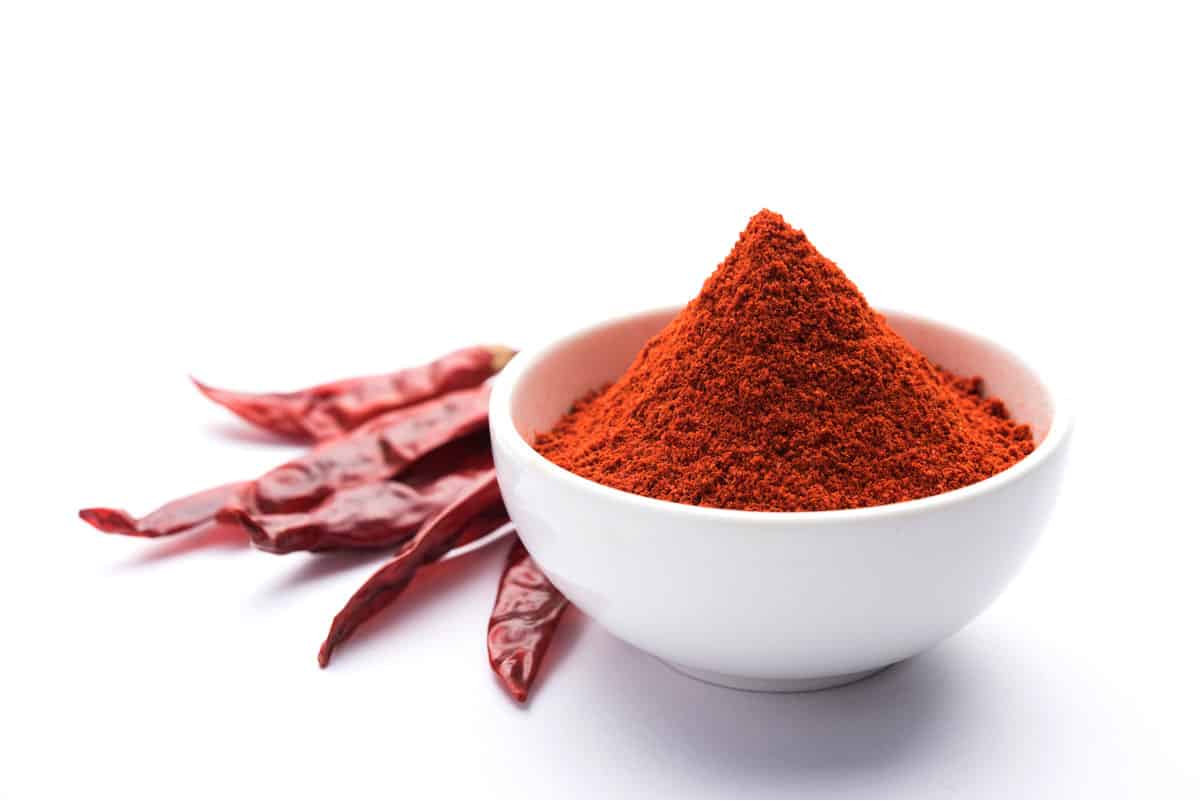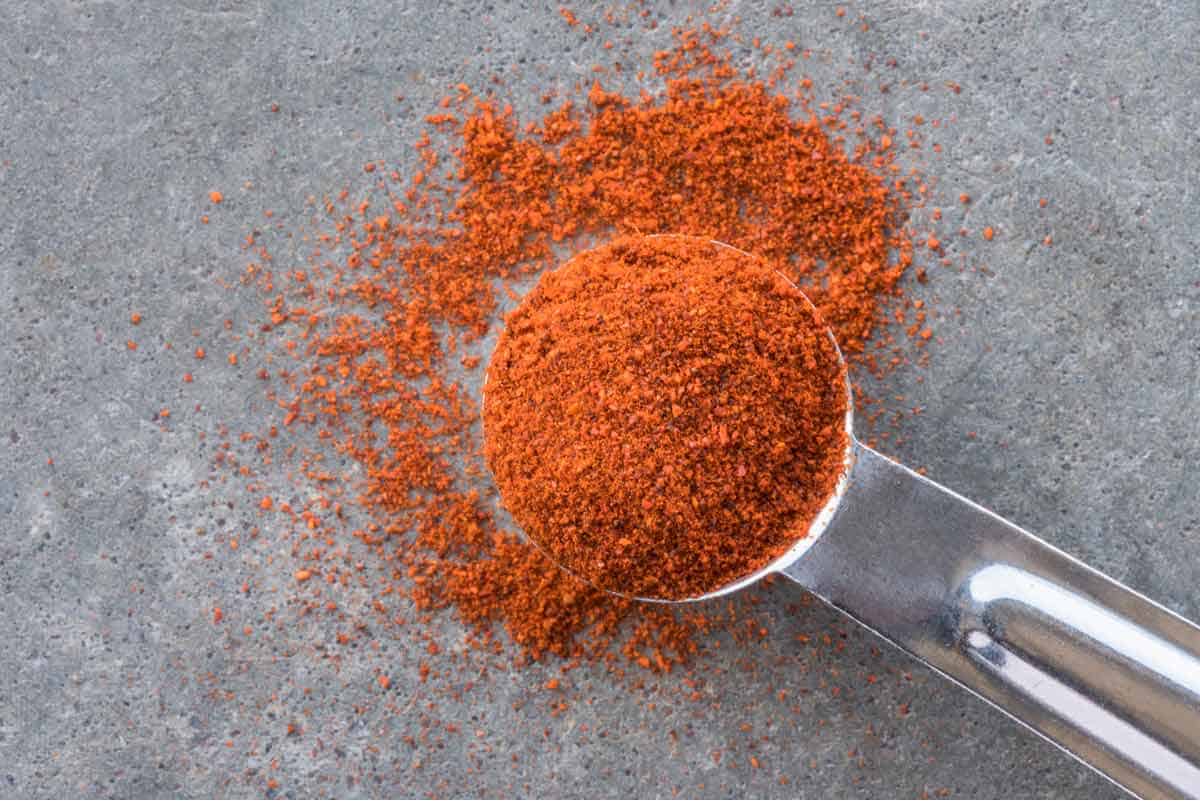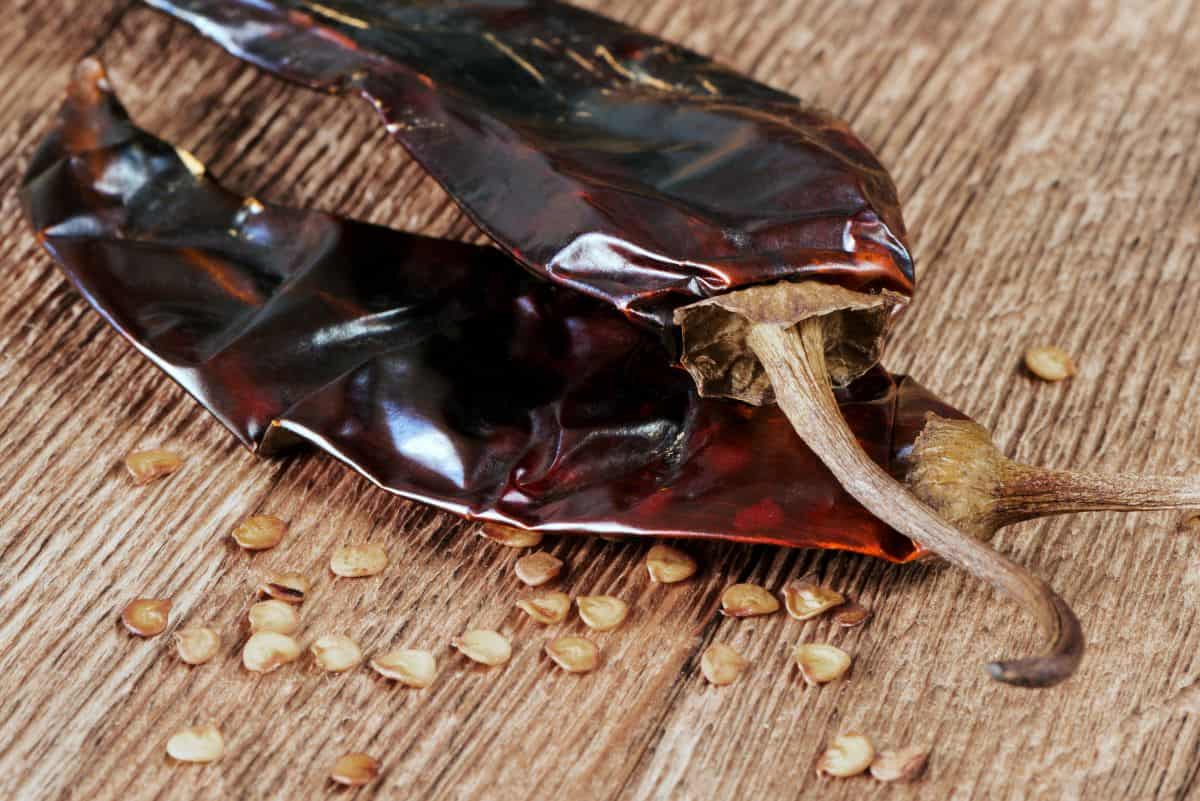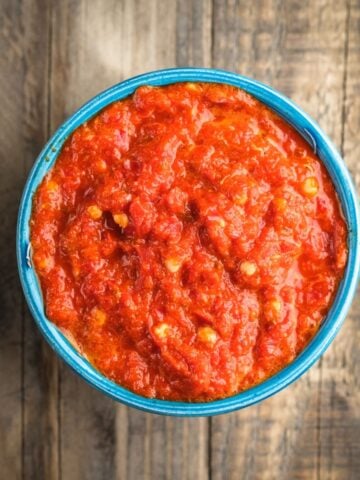Looking to add paprika flavor but are fresh out? My helpful guide will help you make the best-informed decision to find a paprika substitute, no matter the application.

What is Paprika?
Paprika is a pepper powder made by grinding dried peppers of the Capsicum annum species. It originally hails from Hungary and is called Hungarian paprika.
The seasoning shines with its rich, earthy taste and vibrant red-orange color. Paprika also supplies a subtle heat, ranging from mild and sweet to spicy and smoky. The spice is versatile, lending its warm flavor and color to everything from eggs, potatoes, rice, meat, and soups to stews, rubs, and dressings.
Reasons to Substitute Paprika
Why replace such a beloved spice? Here are some common reasons you may need a stand-in:
- Allergies: Paprika contains nightshade peppers. Substitutes avoid an allergic reaction.
- No paprika on hand: Your cupboard is bare, but the recipe calls for that paprika pop. Time for a swap.
- Seeking a different flavor: Maybe you want more heat, smokiness, or sweetness. Substitutes can shift the flavor profile.
- Low on budget: Paprika can be pricey. Substitutes offer cheaper options.
- Dish needs a color boost: Bring back that appetizing orange-red hue.
The Best Paprika Substitute Options
Would you be ready to find that perfect paprika proxy? Here are highly rated alternatives that mimic the color, flavor, and general vibe of paprika:
1. Cayenne Pepper Powder

Why it works: Cayenne pepper powder offers a similar hue and some heat. It provides a generic pepper flavor.
Example dishes: Eggs, potato dishes, chicken, chili, stews.
Measurement guidance: Use half the amount of paprika called for because this ingredient is spicier.
2. Chili Powder

Why it works: Chili powder contains paprika and spices like cumin and oregano for extra flair. It brings a vibrant color.
Example dishes: Meat dishes, stews, marinades, Tex-Mex cuisine.
Measurement guidance: Substitute 1:1.
3. Smoked Paprika

Why it works: This imparts a smoky flavor similar to hot smoked paprika varieties.
Example dishes: Vegetables, eggs, chicken, meat, sauces, grains.
Measurement guidance: Use the same amount as regular paprika.
4. Aleppo Chili Powder

Why it works: Aleppo mimics paprika's mild heat with an earthy flavor.
Example dishes: Roasted veggies, eggs, meat, soups, stews, rubs.
Measurement guidance: Use the same amount as the paprika called for.
5. Crushed Red Pepper Flakes

Why it works: Red pepper flakes supply paprika's red color and punch up the heat.
Example dishes: Pizza, pasta, eggs, meats, dressings, dips.
Measurement guidance: Use half the paprika amount and add with a light hand.
6. Chipotle Powder

Why it works: The smoky spice has a similar red-brown look. It adds a touch of heat.
Example dishes: Chili, taco fillings, soup, stews, dressings, rubs.
Would you like to save this?
Measurement guidance: Substitute 1:1 for the hot paprika amount.
7. Hungarian Sweet Paprika

Why it works: This variety matches paprika's flavor minus the heat.
Example dishes: Chicken, rice, potatoes, salad dressings, dips.
Measurement guidance: Use the same amount called for in the recipe.
8. Bell Peppers

Why it works: A fresh bell pepper lends sweet notes, especially when roasted.
Example dishes: Sauces, dips, dressings, marinades, egg dishes.
Measurement guidance: For 1 teaspoon paprika, sub 2 tablespoon roasted and finely chopped red bell pepper.
9. Ground Ancho Chile

Why it works: Earthy, mildly spicy taste similar to hot paprika varieties.
Example dishes: Chili, taco meat, stews, rubs, marinades.
Measurement guidance: Substitute 1:1 for the hot paprika amount.
10. Hot Sauce

Why it works: Hot sauce adds back that spicy kick and vibrancy.
Example dishes: Eggs, dressings, sauces, soup, stews, pizza.
Measurement guidance: Use sparingly, starting with ¼ teaspoon per 1 teaspoon paprika.
11. Garlic Powder

Why it works: This ingredient provides an earthy, savory flavor like paprika. It lacks the sweetness but gives a similar depth.
Example dishes: Eggs, dressings, marinades, roasted vegetables, soups, stews.
Measurement guidance: Use about ¾ the amount of paprika called for. Start with ½ teaspoon garlic powder per 1 teaspoon paprika.
12. Guajillo Chili Powder

Why it works: Guajillo chili powder has mild heat and an earthy flavor akin to paprika.
Example dishes: Chili, tacos, meats, soups, stews, tomato sauces.
Measurement guidance: Substitute guajillo powder 1:1 for the paprika amount.
Paprika's Common Culinary Uses
To pick the best sub, it helps to know how paprika is traditionally used:
- Chili - Paprika is commonly used for its rich, earthy, smoky flavor and subtle heat. It adds warmth and vibrancy to meat and vegan chilis alike. Paprika substitutes: Ancho chile powder, chili powder, or a combination of cayenne, oregano, and cumin can mimic its smoky flavor in chili.
- Stews and Curries - Paprika is an excellent addition to stews and curries, lending its peppery aroma, slight heat, and beautiful color. It rounds out the other warming spices. Best paprika substitutes: Smoked paprika can provide a similar smoky taste. Chili powder also works well as it contains paprika plus complementary spices.
- Roasts and Braises - A dash of mild paprika enhances roasts and braises with its blend of sweet and savory. Its pepper taste permeates meats and vegetables. Best paprika substitutes: Aleppo chili powder offers mild heat and an earthy taste. Chipotle powder also brings a tasty smoky note.
- Rubs and Marinades - This ingredient's mild spiciness and vibrant hue make it suitable for use at home in zesty rubs and marinades. A little goes a long way to taste and color meats. Paprika alternative: Chili powder, smoked paprika, and ancho powder have that coveted peppery bite. Use them alone or in blends.
- Eggs and Omelettes - A sprinkle of paprika over eggs and omelets adds appetizing color and a kiss of heat. It's a staple spice for breakfast. Paprika substitute: Cayenne pepper and crushed red pepper flakes, hot sauce, pack a similar punch of heat to liven up eggs.
- Soups - Plain paprika provides warmth and earthy flavor to complement a heartier soup. Its peppery taste rounds out other herbs and spices. Paprika substitute: Chipotle powder adds smoky depth, while ancho powder contributes mild heat.
- Salad Dressings - Paprika brightens salad dressings with its vibrant hue. It also supplies a zing of flavor. Paprika substitute: Sweet paprika, cayenne, or finely diced roasted red bell peppers replicate its sweet-spicy taste.
- Potatoes and Vegetables - A dash of paprika over potatoes or veggies adds appetizing color. Its earthy notes also pair perfectly. Paprika substitute: Smoked paprika is an easy swap that enhances potatoes and veggies similarly. Chipotle powder also complements nicely.
- Chicken and Meat - Paprika is commonly used to season and coat chicken and meat. It contributes rich flavor and color. Alternatives: Chili powder, cayenne, and Aleppo powder mirror its mild heat and robust taste.
- Rice Dishes - Paprika infuses rice dishes with warm, earthy pepper essence. It also gives a vibrant hue. Paprika replacement: Sweet paprika or smoked paprika lend similar flavors to rice. Hot sauce works, too.
- Deviled Eggs Paprika lends appetizing color and a touch of heat to deviled eggs. It's a classic garnish. Alternatives: Smoked paprika, cayenne, chili powder, and garlic powder complement deviled eggs nicely.
Helpful Tips for Subbing
- Add the sub early in cooking so the flavor permeates the dish.
- Start with less spice and adjust upwards. You can always add more!
- For sweet paprika, combine two parts mild chili powder with 1 part cinnamon or cocoa powder.
- Mix spices like cayenne, cinnamon, and nutmeg for more complexity.
- Make your versions like chipotle-cumin or cayenne-onion granules.

FAQs
What tastes the same as paprika?
No ingredient tastes the same as paprika since it has a unique taste. But several substitutes like smoked paprika and chili powder get close to mimicking its earthy, warm essence. Aleppo chili powder also has a similar mild heat and taste.
Is paprika and chili powder the same?
Paprika and chili powder are not the same, but both have a fiery flavor. Paprika is made from grinding dried peppers. Chili powder typically contains paprika and spices like cumin, oregano, garlic, and onion granules. So, chili powder has a more complex taste.
Can I use Tabasco instead of paprika?
Tabasco sauce is too hot to substitute for regular paprika. But it can be used sparingly along with other spices to add back some of the heat and color that paprika provides. Start with ¼ teaspoon Tabasco per 1 teaspoon of paprika called for.
Can I add sugar to paprika to make sweet paprika?
You can make your own at home by adding sugar to regular paprika. Use 1 tablespoon of sugar per ¼ cup of regular paprika. Mix well, then allow the sugar to dissolve into the paprika for 1-2 days before using. It should have a sweet taste.
Is sweet paprika just regular paprika?
No, this ingredient has a distinct taste from regular paprika. It is not just regular paprika with sugar added. This spice is created from drying and grinding particular sweet pepper varieties of the Capsicum annum species. Regular paprika can range from mild to spicy.
Is sweet paprika the same as cayenne?
No, they are not the same. The latter is spicy, while sweet paprika has a mild taste. Cayenne pepper powder does contain capsicum-like paprika. But it provides more heat than flavor similarity.
Can I use turmeric instead of paprika?
Turmeric is not the best substitute for paprika. While it offers a vivid orange-yellow color, the flavors are pretty different. Turmeric is earthy and spicy, unlike paprika's sweet pepper flavor. Use only half the amount of turmeric to achieve a similar coloring for appearance.
Is McCormick paprika a Hungarian paprika?
McCormick makes multiple paprika varieties, but not all are Hungarian. To get the proper Hungarian spice, look for the Hungarian, Sweet Hungarian, or Hot Hungarian varieties specifically. Their standard paprika contains a blend of pepper varieties, not just those from Hungary.
What is a good substitute for paprika in fried chicken?
For fried chicken, suitable paprika substitutes include chili powder, smoked paprika, onion powder, or black pepper powder. Chili powder adds complexity. Smoked paprika brings a touch of smokiness. Onion powder and black pepper provide seasoning. Use the same amount called for in the recipe.






Fiona G.
I love paprika!